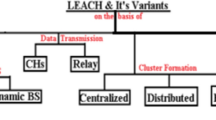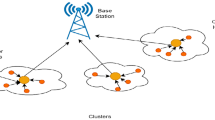Abstract
Wireless sensor networks (WSN) are ad-hoc networks with nodes distributed over large areas which forward data to sink nodes. Nodes in the WSN get depleted of their energy during transmissions. Energy holes are formed in the network due to multiple transmissions disrupting further data transfer in the network. Existing work in literature address the issues of improving the energy efficiency and hence network lifetime by topology control, optimal cluster-head selection and scheduling to reduce collisions. We consider a circular WSN with multiple levels in which the nodes are distributed randomly with node density higher towards the sink. The vast circular area is divided into a number of sectors. Dynamic cluster head selection in each sub-sector is implemented using the Whale Optimization Algorithm. We evaluate the performance of the proposed approach in terms of the residual energy and network lifetime. We analyse the proposed model and prove that a nominally balanced energy depletion is achievable in the circular WSN with sectorization. The performance of the proposed approach is compared with the PSO and LEACH protocol implementations. It is observed from the results obtained that with the proposed approach the residual energy ratio is reduced by 50% and 39% for an initial energy of 50 Joules compared to PSO and LEACH protocols. As the initial energy increases there is improvement in percentage reduction in residual energy ratio thereby improving the lifetime of the network.





Similar content being viewed by others
References
Manshahia, M. S. (2016). Wireless sensor networks: A survey. International Journal of Scientific & Engineering Research, 7(4), 710–716.
Asharioun, H., Asadollahi, H., Wan, T. C., & Gharaei, N. (2015). A survey on analytical modeling and mitigation techniques for the energy hole problem in corona-based wireless sensor network. Wireless Personal Communications, 81(1), 161–187.
Ran, L.G., Zhang, H., & Gong, S. (2010). Improving on LEACH protocol of wireless sensor networks using fuzzy. Journal of Information & Computational Science, 7(3), 767–775.
Rajeev, S., & Manu, M. S. (2017). An energy efficient grid based static node deployment strategy for wireless sensor networks. International Journal of Electronics & Information Engineering, 7.
Mehmood, A., Mauri, J. L., Mauri, M., & Song, H. (2015). Improvement of the wireless sensor network lifetime using LEACH with vice-cluster head. Ad Hoc & Sensor Wireless Networks, 28(1–2), 1–17.
Arghavani, M., Esmaeili, M., Esmaeili, M., Mohseni, F., & Arghavani, A. (2017). Optimal energy aware clustering in circular wireless sensor network. Ad Hoc Networks, 65, 91–98.
Jadhav, A. R., & Shankar, T. (2017). Whale optimization based energy-efficient cluster head selection algorithm for wireless sensor networks. Computer Science Journal, 2017, 1–22.
Yong, Z., & Pei, Q. (2012). An energy-efficient clustering routing algorithm based on distance and residual energy for wireless sensor networks. Procedia Engineering, 29, 1882–1888.
Wang, Y. C., Hu, C. C., & Tseng, Y. C. (2007). Efficient placement and dispatch of sensors in a wireless sensor network. IEEE Transactions on Mobile Computing, 7, 262–274.
Ahmed, M. M., Houssein, E. H., Ella Hassanien, A., Taha, A., & Hassanien, E. (2017). Maximizing lifetime of wireless sensor networks based on whale optimization algorithm. Proceedings of the International Conference on Advanced Intelligent Systems and Informatics, 639, 724–733.
Wu, X., Chen, G., & Das, S. K. (2008). Avoiding energy holes in wireless sensor networks with nonuniform node distribution. IEEE Transactions on Parallel and Distributed Systems, 19(5), 710–720.
Guravaiah, K., & Velusamy, R. L. (2018). BEACH: Balanced energy and adaptive cluster head selection algorithm for wireless sensor networks. Adhoc & Sensor Wireless Networks, 42, 199–225.
SalehiPanahi, M., & Abbaszadeh, M. (2018). Proposing a method to solve energy hole problem in wireless sensor networks. Alexandria Engineering Journal, 57(3), 1585−1590.
Mehmood, A., Khan, S., Zhang, D., Lloret, J., Ahmed, S.H. (2014). Iotec: Iot based efficient clustering protocol for wireless sensor network. In International industrial information systems conference (IIISC 2014), Chiang Mai, Thailand, Jan 21–24.
Mirjalili, S., & Lewis, A. (2016). The whale optimization algorithm. Advances in Engineering Software, 95, 51–67.
Anand, V., & Pandey, S. (2017). Particle swarm optimization and harmony search based clustering and routing in wireless sensor networks. International Journal of Computational Intelligence Systems, 10(1), 1252–1262.
Zhao, S. Z., & Sunganthan, P. N. (2011). Two-lbests based multi-objective particle swarm optimizer. Engineering Optimization, 43(1), 1–17.
Yadav, R. K., Kumar, V., & Kumar, R. (2015). A discrete particle swarm optimization base clustering algorithm for wireless sensor networks. In Emerging ICT for bridging the future-proceedings of the 49th annual convention of the computer society of India CSI (Vol. 2, pp. 137–144).
Yoon, Y., & Kim, Y. H. (2013). An efficient genetic algorithm for maximum coverage deployment in wireless sensor networks. IEEE Transactions on Cybernetics, 43, 1473–1483.
Wang, S., & Nie, J. (2010). Energy efficiency optimization of cooperative communication in wireless sensor networks. EURASIP Journal on Wireless Communications and Networking, 10, 162326.
Ni, Q., Pan, Q., Du, H., Cao, C., & Zhai, Y. (2017). A novel cluster head selection algorithm based on fuzzy clustering and particle swarm optimization. IEEE/ACM Transactions on Computational Biology and Bioinformatics, 10, 76–84.
Farsi, M., Elhosseini, M. A., Badawy, M., Arafat Ali, H., & Zain Eldin, H. (2019). Deployment techniques in wireless sensor networks, coverage and connectivity: A survey. IEEE Access, 7, 28940–28954.
Author information
Authors and Affiliations
Corresponding author
Additional information
Publisher's Note
Springer Nature remains neutral with regard to jurisdictional claims in published maps and institutional affiliations.
Appendix
Rights and permissions
About this article
Cite this article
Priyanka, B.N., Jayaparvathy, R. & DivyaBharathi, D. Efficient and Dynamic Cluster Head Selection for Improving Network Lifetime in WSN using Whale Optimization Algorithm. Wireless Pers Commun 123, 1467–1481 (2022). https://doi.org/10.1007/s11277-021-09192-7
Accepted:
Published:
Issue Date:
DOI: https://doi.org/10.1007/s11277-021-09192-7




